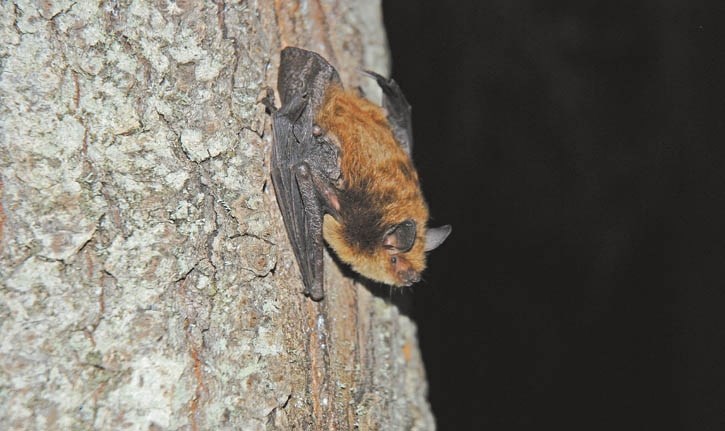For the first time, Parks Canada researchers have discovered evidence of bats hibernating in a cave in Banff National Park.
Researchers believe the bats are endangered little brown myotis, but they say they are sending bat bones found in the cave near the Icefields Parkway to a wildlife genetics laboratory in British Columbia for confirmation.
Parks Canada wildlife researchers say the find is extremely important because hibernating bats are most at risk to white-nose syndrome, a fungal disease killing off millions of bats in Canada’s eastern provinces and the United States.
“This is a really exciting discovery,” said Anne Forshner, a Parks Canada wildlife ecologist focusing on species of special concern, during a Bow Valley Naturalists’ talk last week.
“That’s the first cave where we’ve found any evidence of hibernacula in Banff, Yoho and Kootenay national parks.”
White-nose syndrome, a fungus introduced from Europe, was first discovered in a cave in New York State in 2006 and detected in Canada a few years later. In the last decade, the disease has killed off an estimated seven million bats and biologists expect it to continue spreading.
A white fuzzy fungal growth is seen around the nose and on the wings of infected bats. The disease interrupts their hibernation and they quickly use up fat reserves that get them through winter. Infected bats usually dehydrate or starve to death.
“We’re really concerned,” said Forshner. “White-nose syndrome is spreading rapidly and we know now it’s found in bats as far west as Thunder Bay.”
Bat to bat transmission remains the main mode of transmission of the deadly disease and researchers are trying to prevent the spread of the disease to the west, including educating cavers on decontaminating gear.
“We’re wanting to prevent the leap of this fungus from the eastern population of bats to western populations, and we’re hoping it could buy us some time to figure out a little bit more about bats here,” said Forshner.
“We want to do our best to make sure bats continue into the future, but right now we don’t know a lot about bats. We have some basic information, but we don’t have enough detail to do a lot for them.”
There are nine species of bats in Alberta and Banff National Park is believed to have at least six of those, including big brown bat, long-eared bat, long-legged bat, silver haired bat, hoary bat and the endangered little brown bat.
British Columbia has the greatest bat diversity in the country, home to 16 species.
The northern myotis is another endangered bat, and research in Kootenay National Park in 1983 found evidence of calls from this species. Other than that, there is no other information on northern myotis in that park.
Forshner said Parks is trying to record bat calls as a way to get a better handle on bat distribution and abundance, with an emphasis on finding hibernacula and maternity roosting sites.
“They all look a lot the same and interestingly their calls look a lot similar too,” she said, noting bat calls are recorded in the ultrasonic sound range.
“We’re going to have our work cut out figuring out who’s who and where they are, how many there are, where they’re hibernating and where the females are having their young.”
Parks Canada is part of the North American Bat Monitoring Program, a coordinated effort in the U.S. and Canada to try to track and monitor bats on a broad scale, including bat population trends and detection of early warning signs of population declines.
In the mountain parks, researchers also drive a vehicle fitted with a recording device along a couple of different routes, including Bow Valley Parkway in Banff and the road to Takkakaw Falls in Yoho, trying to pick up bat calls.
There is also stationary recording equipment set up in front country and backcountry locations.
Forshner said the work in caves and mines is an important piece of the puzzle.
She said researchers made the discovery of the bat hibernacula in a cave along the Icefields Parkway on Dec. 21 last year, when they realized they needed to replace a battery in one of the bat detectors.
“They found a number of little guys hibernating in the cave,” said Forshner.
“They were also looking around for other signs. We were able to find a number of different bat bones in the cave as well as guano, which looks a lot like mouse droppings.”
Cave climate data is also being collected. Research suggests white-nose syndrome fungus is basically neutralized around 20 C, but thrives in low temperatures of about 5-14 C and high levels of humidity.
Forshner said researchers have placed temperature and relative humidity loggers to get a sense of conditions in the cave. In the cave where hibernating bats were found, the temperature and humidity did not change at all, sitting at four degrees and 100 per cent humidity, even though temperatures fluctuated widely outside.
“This is really good for bats, because they don’t like fluctuations in temperature and relative humidity when they’re hibernating; it makes them arouse from their hibernation,” she said.
Reg Bunyan of the Bow Valley Naturalists said the group welcomes the research being done, noting there is very little known about bats in Banff.
“We’re all concerned about the spread of white-nose syndrome, and being proactive and monitoring to see what we have here is important,” he said.
“I think this work is quite exciting. In all my time in Banff National Park, I’ve seen wolverines and grizzly bears, but I have personally never seen a bat in Banff National Park.”




